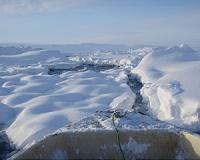| . |  |
. |
Washington DC (SPX) Mar 30, 2011 In a finding that has global implications for climate research, scientists have discovered that when icebergs cool and dilute the seas through which they pass for days, they also raise chlorophyll levels in the water that may in turn increase carbon dioxide absorption in the Southern Ocean. An interdisciplinary research team supported by the National Science Foundation (NSF) highlighted the research this month in the journal Nature Geosciences. The research indicates that "iceberg transport and melting have a role in the distribution of phytoplankton in the Weddell Sea," which was previously unsuspected, said John J. Helly, director of the Laboratory for Environmental and Earth Sciences with the San Diego Supercomputer Center at the University of California, San Diego and Scripps Institution of Oceanography. Helly was the lead author of the paper, "Cooling, Dilution and Mixing of Ocean Water by Free-drifting Icebergs in the Weddell Sea," which was first published in the journal Deep-Sea Research Part II. The results indicate that icebergs are especially likely to influence phytoplankton dynamics in an area known as "Iceberg Alley," east of the Antarctic Peninsula, the portion of the continent that extends northwards toward Chile. The latest findings add a new dimension to previous research by the same team that altered the perception of icebergs as large, familiar, but passive, elements of the Antarctic seascape. The team previously showed that icebergs act, in effect, as ocean "oases" of nutrients for aquatic life and sea birds. The teams's research indicates that ordinary icebergs are likely to become more prevalent in the Southern Ocean, particularly as the Antarctic Peninsula continues a well-documented warming trend and ice shelves disintegrate. Research also shows that these ordinary icebergs are important features of not only marine ecosystems, but even of global carbon cycling. "These new findings amplify the team's previous discoveries about icebergs and confirm that icebergs contribute yet another, previously unsuspected, dimension of physical and biological complexity to polar ecosystems," said Roberta L. Marinelli, director of the NSF's Antarctic Organisms and Ecosystems Program. NSF manages the U.S. Antarctic Program, through which it coordinates all U.S. scientific research and related logistics on the southernmost continent and aboard ships in the Southern Ocean. The latest findings document a persistent change in physical and biological characteristics of surface waters after the transit of an iceberg, which has important effects on phytoplankton populations, clearly demonstrating "that icebergs influence oceanic surface waters and mixing to greater extents than previously realized," said Ronald S. Kaufmann, associate professor of marine science and environmental studies at the University of San Diego and one of the authors of the paper. The researchers studied the effects by sampling the area around a large iceberg more than 32 kilometers (20 miles) long; the same area was surveyed again ten days later, after the iceberg had drifted away. After ten days, the scientists observed increased concentrations of chlorophyll a and reduced concentrations of carbon dioxide, as compared to nearby areas without icebergs. These results are consistent with the growth of phytoplankton and the removal of carbon dioxide from the ocean. The new results demonstrate that icebergs provide a connection between the geophysical and biological domains that directly affects the carbon cycle in the Southern Ocean, Marinelli added. In 2007, the same team published findings in the journal Science that icebergs serve as "hotspots" for ocean life with thriving communities of seabirds above and a web of phytoplankton, krill and fish below. At that time, the researchers reported that icebergs hold trapped terrestrial material, which they release far out at sea as they melt, a process that produces a "halo effect" with significantly increased nutrients and krill out to a radius of more than three kilometers (two miles). The new research was conducted as part of a multi-disciplinary project that also involved scientists from the Monterey Bay Aquarium Research Institute, University of South Carolina, University of Nevada, Reno, University of South Carolina, Brigham Young University, and the Bigelow Laboratory for Ocean Sciences. Scripps Institution of Oceanography research biologist Maria Vernet and graduate student Gordon Stephenson also contributed to the paper.
Share This Article With Planet Earth
Related Links Scripps Institution of Oceanography Beyond the Ice Age
 Study Sheds Light On How Heat Is Transported To Greenland Glaciers
Study Sheds Light On How Heat Is Transported To Greenland GlaciersWoods Hole MA (SPX) Mar 30, 2011 Warmer air is only part of the story when it comes to Greenland's rapidly melting ice sheet. New research by scientists at Woods Hole Oceanographic Institution (WHOI) highlights the role ocean circulation plays in transporting heat to glaciers. Greenland's ice sheet has lost mass at an accelerated rate over the last decade, dumping more ice and fresh water into the ocean. Between 2001 and ... read more |
|
| The content herein, unless otherwise known to be public domain, are Copyright 1995-2010 - SpaceDaily. AFP and UPI Wire Stories are copyright Agence France-Presse and United Press International. ESA Portal Reports are copyright European Space Agency. All NASA sourced material is public domain. Additional copyrights may apply in whole or part to other bona fide parties. Advertising does not imply endorsement,agreement or approval of any opinions, statements or information provided by SpaceDaily on any Web page published or hosted by SpaceDaily. Privacy Statement |